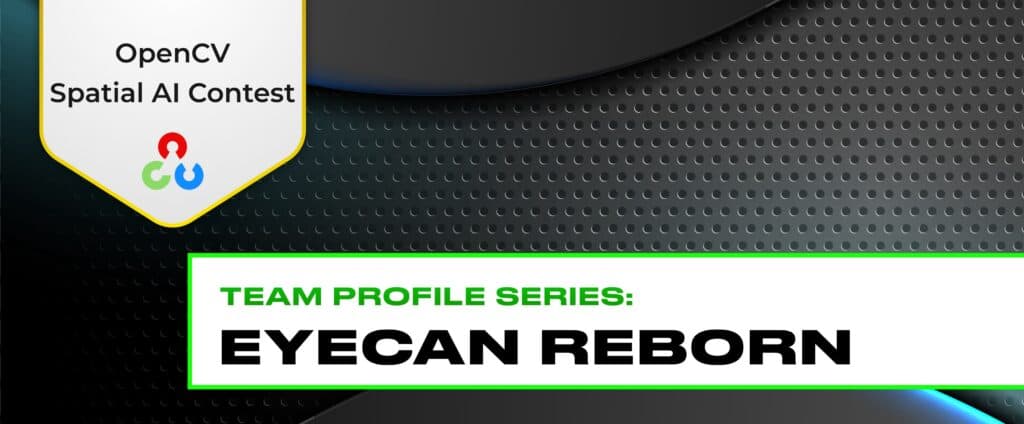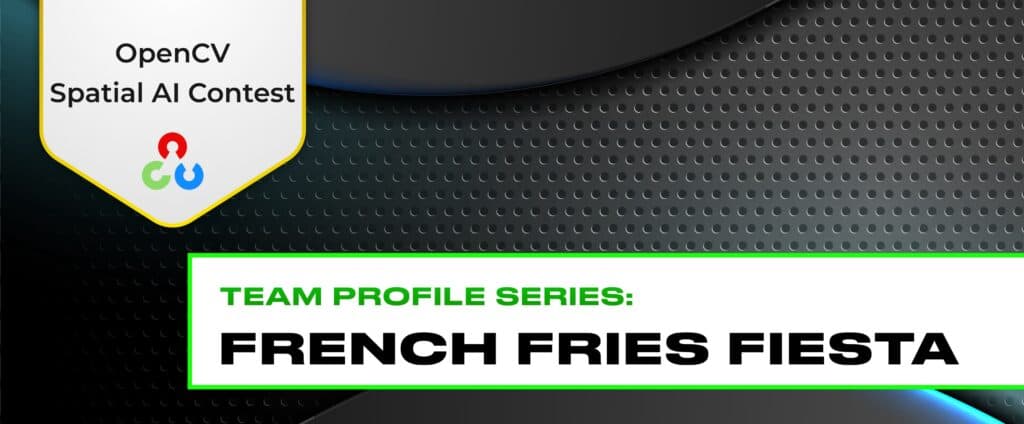
The OpenCV Spatial AI Contest, where 50 teams are building LEGO-based versions of industrial manufacturing solutions with the artificial intelligence power of OpenCV AI Kit, is in full-swing as teams work on their projects with an eye toward the April 4th build deadline. In this post we’ll cover some of the recent highlights on social media and learn about a few of the participating teams: EyeCan Reborn and French Fries Fiesta. In case you missed it, go read the first post in this series. Let’s go!

#OAKDLiteContest Hashtag Highlights
- LA Inoculum is so close to having their prototype finished
- Sergio Velmay of Getafe Poka-yokers was our guest on the March 3rd episode of OpenCV Weekly Webinar showing his system for improving manufacturing processes and eliminating defects in assembly
- Matteo Poggi of Team EyeCan Reborn was our guest on the February 24th episode of OpenCV Weekly Webinar showing their 3D capture solution for the Metaverse
- Project ARNEIS has some tasty results from their bottle recognition system as well as a new logo!
- Want to see your team’s content here? Post with the #OAKDLiteContest hashtag!

Team Profile: EyeCan Reborn
What is your project? Briefly describe your problem statement and proposed solution
With the advent of metaverse, the interaction between real and virtual worlds is going to be tighter and tighter. As we bring some virtual content in our world through augmented reality, we may also bring some real objects into the metaverse, to be able to manipulate them inside the virtual world. In our project, we implement a scanning station to “teleport” a real object to metaverse, by simply framing it with the OAKDLite from different view angles and by employing the most recent neural rendering technologies developed so far.
What is your team origin story? How did you get together?
Daniele and I where both PhD students at the University of Bologna. Then, after the postdoc, we followed two pathways. Daniele had a vision two years ago, to create an innovative start-up here in Bologna, Eyecan.ai, and to bring a taste of research and academia in the industrial world. Since then, we often work together to bridge the gap between the two worlds, and the OAKDLite contest seemed a perfect chance for doing this!
How did you decide what problem to solve?
We are deeply fascinated by these very recent works on neural rendering and, from a practical point of view, we are eager to find a real application for which these technology can make the difference, both in industry or for entertainment. The advent of metaverse just gave us the hint: what if we can bring objects there? Which further applications we could imagine starting from this? Then we decided to find this out!
What is the most exciting part of #OAKDLiteContest to you?
To solve some real problems with peculiar instruments (the OAKDLite camera is great!). From a second perspective, we also liked a lot the idea of a challenge focused on using LEGO. It adds some drawback flavor that makes the whole contest even better!
What do you think / feel upon learning you were selected as a Finalist?
We were very happy, of course! In that moment we realized we were going to bring our idea out of our minds and make it a real thing, I believe this is the most exciting part of the creative process.
What if anything has surprised you so far about the other projects you’ve seen?
We particularly liked how many applications found place in this challenge. It is great to see how many different projects the participants could imagine off starting from some LEGO blocks!
Do you have any words for your fellow competitors?
Well, the Eyecan Unicorns wish the best of luck to all the participants … and to enjoy this unique challenge at the most! It’s never too late to play with LEGO 🙂 even for some serious stuff!
Where should readers follow you, to best keep up with your progress? (Twitter, LinkedIn, etc)
You can follow Eyecan.ai LinkedIn account (https://www.linkedin.com/company/eyecan-ai) for the latest updates!

Team Profile: French Fries Fiesta
What is your project? Briefly describe your problem statement and proposed solution
Strangely, potato sorting is still manual operation. Some machines have been designed that use computer vision technology, but it seems that humans are still needed to detect all possible defects such as rot, tool marks, sprouting, etc.
Machines are already quite efficient at detecting rotten potatoes using color images. In this challenge I would like to address the detection of potatoes that have been damaged by tools. I try to use 3D vision to detect tool marks
What is your team origin story? How did you get together?
Actually this is a one man team, just me
How did you decide what problem to solve?
It came from a wish to develop a solution for sustainable food production
I believe that IA and especially computer vision will be a key enabler to make food production more sustainable for a growing world population
This project is a small attempt at showing how technology can help reduce waste during food production processes.
What is the most exciting part of #OAKDLiteContest to you?
I really like the idea of being able to explore some new ideas for using 3D computer vision.
What do you think / feel upon learning you were selected as a Finalist?
That came as a surprise. And now there is a lot of pressure to finish the project.
What if anything has surprised you so far about the other projects you’ve seen?
I read the list of all 50 finalists and keep wondering what is hiding behind each team name and project. Can’t wait to see the end results.
Do you have any words for your fellow competitors?
I wish them to have as much fun as I do (Lego Technic is a first for me)
That’s All For Now!
Thanks for reading this second in our series of highlights and team profiles. You can expect to learn much more about the teams in our contest as we continue through the build phase. If you want to see the latest before anyone else, subscribe to the OpenCV Newsletter, and follow the #OAKDLiteContest hashtag on Twitter and LinkedIn. See you next time!











5K+ Learners
Join Free VLM Bootcamp3 Hours of Learning